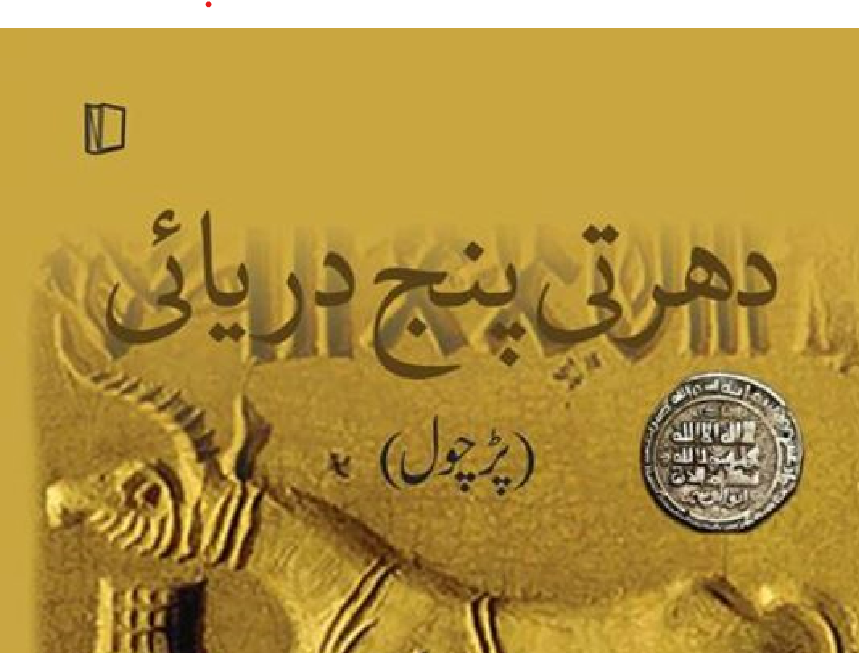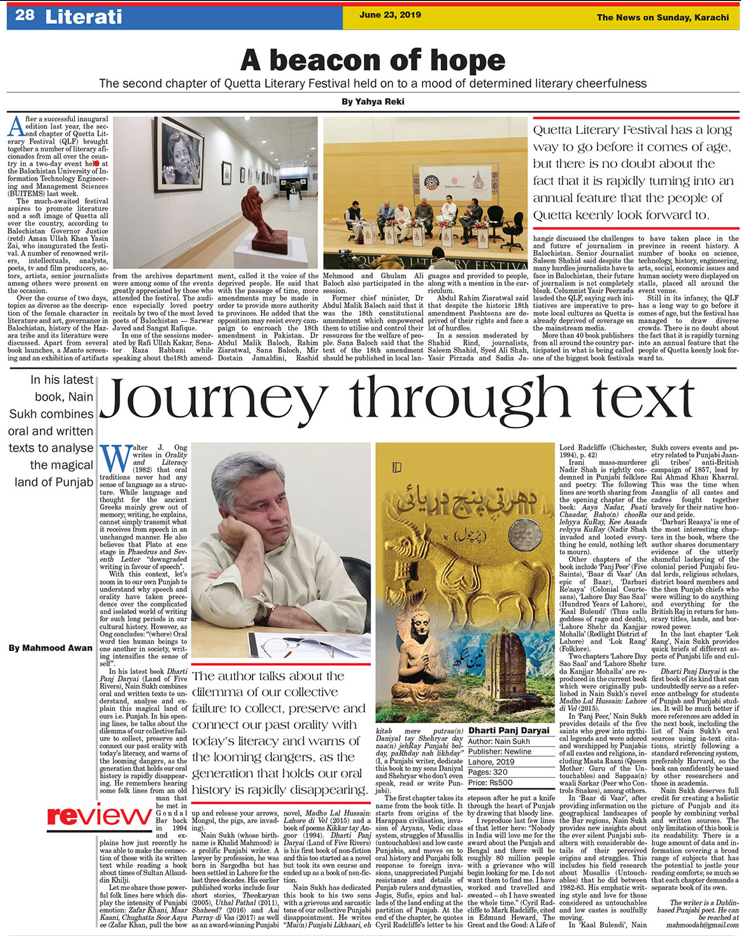Mahmood Awan (The News on Sunday, 23rd June 2019)
Walter J. Ong writes in Orality and Literacy (1982) that oral traditions never had any sense of language as a structure. While language and thought for the ancient Greeks mainly grew out of memory; writing, he explains, cannot simply transmit what it receives from speech in an unchanged manner. He also believes that Plato at one stage in Phaedrus and Seventh Letter “downgraded writing in favour of speech”.
With this context, let’s zoom in to our own Punjab to understand why speech and orality have taken precedence over the complicated and isolated world of writing for such long periods in our cultural history. However, as Ong concludes: “(where) Oral word ties human beings to one another in society, writing intensifies the sense of self”.
In his latest book Dharti Panj Daryai (Land of Five Rivers), Nain Sukh combines oral and written texts to understand, analyse and explain this magical land of ours i.e. Punjab. In his opening lines, he talks about the dilemma of our collective failure to collect, preserve and connect our past orality with today’s literacy, and warns of the looming dangers, as the generation that holds our oral history is rapidly disappearing. He remembers hearing some folk lines from an old man that he met in Gondal Bar back in 1994 and explains how just recently he was able to make the connection of those with its written text while reading a book about times of Sultan Allauddin Khilji.
Let me share those powerful folk lines here which display the intensity of Punjabi emotion: Zafar Khani, Maar Kaani, Chughatta Soor Aaya ee (Zafar Khan, pull the bow up and release your arrows, Mongol, the pigs, are invading).
Nain Sukh (whose birthname is Khalid Mahmood) is a prolific Punjabi writer. A lawyer by profession, he was born in Sargodha but has been settled in Lahore for the last three decades. His earlier published works include four short stories, Theekaryan (2005), Uthal Pathal (2011), Shaheed? (2016) and Aai Purray di Vaa (2017) as well as an award-winning Punjabi novel, Madho Lal Hussain: Lahore di Vel (2015) and a book of poems Kikkar tay Angoor (1994). Dharti Panj Daryai (Land of Five Rivers) is his first book of non-fiction and this too started as a novel but took its own course and ended up as a book of non-fiction.
Nain Sukh has dedicated this book to his two sons with a grievous and sarcastic tone of our collective Punjabi disappointment. He writes “Mai(n) Punjabi Likhaari, eh kitab mere putraa(n) Daniyal tay Shehryar day naa(n) jehRay Punjabi bolday, paRhday nah likhday” (I, a Punjabi writer, dedicate this book to my sons Daniyal and Shehryar who don’t even speak, read or write Punjabi).
The first chapter takes its name from the book title. It starts from origins of the Harappan civilisation, invasion of Aryans, Vedic class system, struggles of Musallis (untouchables) and low caste Punjabis, and moves on to oral history and Punjabi folk response to foreign invasions, unappreciated Punjabi resistance and details of Punjab rulers and dynasties, Jogis, Sufis, epics and ballads of the land ending at the partition of Punjab. At the end of the chapter, he quotes Cyril Radcliffe’s letter to his stepson after he put a knife through the heart of Punjab by drawing that bloody line.
I reproduce last few lines of that letter here: “Nobody in India will love me for the award about the Punjab and Bengal and there will be roughly 80 million people with a grievance who will begin looking for me. I do not want them to find me. I have worked and travelled and sweated – oh I have sweated the whole time.” (Cyril Radcliffe to Mark Radcliffe, cited in Edmund Heward, The Great and the Good: A Life of Lord Radcliffe (Chichester, 1994), p. 42)
Irani mass-murderer Nadir Shah is rightly condemned in Punjabi folklore and poetry. The following lines are worth sharing from the opening chapter of the book: Aaya Nadar, Paati Chaadar, Baho(n) chooRa lehyya KuRay, Kee Asaada rehyya KuRay (Nadir Shah invaded and looted everything he could, nothing left to mourn).
Other chapters of the book include ‘Panj Peer’ (Five Saints), ‘Baar di Vaar’ (An epic of Baar), ‘Darbari Re’aaya’ (Colonial Courtesans), ‘Lahore Day Sao Saal’ (Hundred Years of Lahore), ‘Kaal Bulendi’ (Thus calls goddess of rage and death), ‘Lahore Shehr da Kanjjar Mohalla’ (Redlight District of Lahore) and ‘Lok Rang’ (Folklore).
Two chapters ‘Lahore Day Sao Saal’ and ‘Lahore Shehr da Kanjjar Mohalla’ are reproduced in the current book which were originally published in Nain Sukh’s novel Madho Lal Hussain: Lahore di Vel (2015).
In ‘Panj Peer,’ Nain Sukh provides details of the five saints who grew into mythical legends and were adored and worshipped by Punjabis of all castes and religions, including Maata Raani (Queen Mother: Guru of the Untouchables) and Sappaa(n) waali Sarkar (Peer who Controls Snakes), among others.
In ‘Baar di Vaar’, after providing information on the geographical landscapes of the Bar regions, Nain Sukh provides new insights about the ever silent Punjabi subaltern with considerable details of their perceived origins and struggles. This includes his field research about Musallis (Untouchables) that he did between 1982-83. His emphatic writing style and love for those considered as untouchables and low castes is soulfully moving.
In ‘Kaal Bulendi’, Nain Sukh covers events and poetry related to Punjabi Jaangli tribes’ anti-British campaign of 1857, lead by Rai Ahmad Khan Kharral. This was the time when Jaanglis of all castes and cadres fought together bravely for their native honour and pride.
‘Darbari Reaaya’ is one of the most interesting chapters in the book, where the author shares documentary evidence of the utterly shameful lackeying of the colonial period Punjabi feudal lords, religious scholars, district board members and the then Punjab chiefs who were willing to do anything and everything for the British Raj in return for honorary titles, lands, and borrowed power.
In the last chapter ‘Lok Rang’, Nain Sukh provides quick briefs of different aspects of Punjabi life and culture.
Dharti Panj Daryai is the first book of its kind that can undoubtedly serve as a reference anthology for students of Punjab and Punjabi studies. It will be much better if more references are added in the next book, including the list of Nain Sukh’s oral sources using in-text citations, strictly following a standard referencing system, preferably Harvard, so the book can confidently be used by other researchers and those in academia.
Nain Sukh deserves full credit for creating a holistic picture of Punjab and its people by combining verbal and written sources. The only limitation of this book is its readability. There is a huge amount of data and information covering a broad range of subjects that has the potential to jostle your reading comforts; so much so that each chapter demands a separate book of its own.
Dharti Panj Daryai
Author: Nain Sukh
Publisher: Newline Lahore, 2019
Pages: 320
Price: Rs500
Published on 23rd June 2019 in The News on Sunday.
https://www.thenews.com.pk/tns/detail/567991-journey-text


